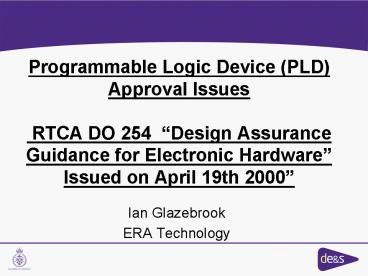Programmable Logic Device PLD Approval Issues RTCA DO 254 Design Assurance Guidance for Electronic H - PowerPoint PPT Presentation
1 / 18
Title:
Programmable Logic Device PLD Approval Issues RTCA DO 254 Design Assurance Guidance for Electronic H
Description:
Descriptions of the evidence that indicate that the objectives have ... Based on Table A-1, RTCA DO 254, Page A-2. Approval ... of time-related ... – PowerPoint PPT presentation
Number of Views:165
Avg rating:3.0/5.0
Title: Programmable Logic Device PLD Approval Issues RTCA DO 254 Design Assurance Guidance for Electronic H
1
Programmable Logic Device (PLD) Approval Issues
RTCA DO 254 Design Assurance Guidance for
Electronic Hardware Issued on April 19th 2000
- Ian Glazebrook
- ERA Technology
2
Presentation Overview
- Introduction to RTCA DO 254
- Objectives
- Approval (Certification) Issues and Problems
- Coded Components including
- Field Programmable Gate Array (FPGA)
- Programmable Systems-on-Chip (PSoC)
- Complex Programmable Logic Device (CPLD)
- Application Specific Integrated Circuit (ASIC)
3
Presentation Overview
- Approval is a system function and is granted for
a product
4
Standards Hierarchy Context
JSP 553 Regulations FAR, CS eg FAR/CS 251309
Safety Assessment SAE ARP 4761
Def Stan 00-56 System SafetySAE ARP 4754,CS
251309
Software Safety RTCA DO-178B Def Stan 00-55
Hardware Safety RTCA DO-254 Def Stan 00-54
Environmental RTCA DO-160Def Stan Def Stan
59-411
5
RTCA DO 254 Introduction
- Guidelines for the production of PLDs for
airborne systems and equipment - Given "force" by the FAA AC 20-152 on 30th June
2005 - Based on RTCA DO 178B (Software), often
considered the same as SW as they are programmed
like SW - Incorrect
6
RTCA DO254 Introduction
- Provides level of rigor based on severity
- Objectives for Hardware life cycle processes
- Descriptions of design considerations and
activities for achieving those objectives - Descriptions of the evidence that indicate that
the objectives have been satisfied
7
Objectives By Assurance Level
Based on Table A-1, RTCA DO 254, Page A-2
8
Approval (Certification) Process
RTCA DO 254 Figure 2.3, Page 18
9
Complex PLD Issues
- Similar to Software
- Cannot be 100 tested for all combinations of
inputs and paths - Are more likely to have design or implementation
errors - Are prone to unanticipated interactions
10
Complex PLD Issues
- Similar to Software
- It is a common observation during development
that the requirements are inadequate or
incomplete - They are developed by tools which may introduce
additional errors and gives rise to Tool
Qualification (See Section 11.4)
11
Additional Considerations for PLDs
- Issues over and above Software
- Performance of time-related functions
- Signal noise and cross-talk and signal timing
relationships - Signal glitches in asynchronous logic circuits
- Possible state transitions, anticipated or not
- Supply voltage and current demands
- Obsolescence
- Single Event Upset (SEU)
12
Commercial Off The Shelf (COTS) Considerations
- The rigor of the development processes for COTS
should be commensurate with its Assurance Level
and intended use - When COTS data is not available approval
approaches for COTS could include - Electronic Component Management as recommended by
RTCA DO 254 Section 11.2 - Product Service Experience as recommended by RTCA
DO 254 Section 11.3
13
Tool Assessment and Qualification
- For Levels A and B assurance compliance should be
provided - Development Tools
- Verification Tools
- A claim for credit of relevant tool history will
need to be justified (See Section 11.4.1, Item 5) - Possible tools need to be included as part of
planning and Supplier Selection process
14
Tool Assessment and Qualification
- Use of tools requires Authority (Approval)
Agreement - Tool data and evidence that show they perform
their intended functions - Difficult
15
Conclusions and Recommendations
- Robust and accurate plans early in the programme
- Agree PHAC, DAL and the certification basis at
programme start - Future proofing and obsolescence robustness
assessments - Focus on proven techniques and approaches
- Leading / bleeding edge is not always the best
solution
16
Conclusions and Recommendations
- Ensure robust and controlled Transition Criteria
- Ensure Requirements are controlled and accurate,
including provision for Derived Requirements
17
QUESTIONS?
- Additional ReferencesIPT Guidance for
Acquisition of Systems with Complex Programmable
Hardware using DO-254http//www.era.co.uk/assc/sy
stems.aspFAA System Safety Handbook
http//www.faa.gov/library/manuals/aviation/risk_
management/ss_handbook/
18
QUESTIONS?
Advisory Circulars, including 20-152
http//www.airweb.faa.gov/Regulatory_and_Guidance
_Library/rgAdvisoryCircular.nsf/Certification
Authorities Software Team (CAST) Position Papers
http//www.faa.gov/aircraft/air_cert/design_appro
vals/air_software/cast/cast_papers/



























